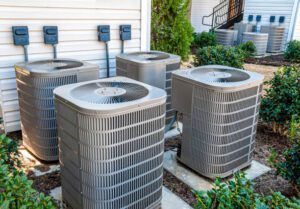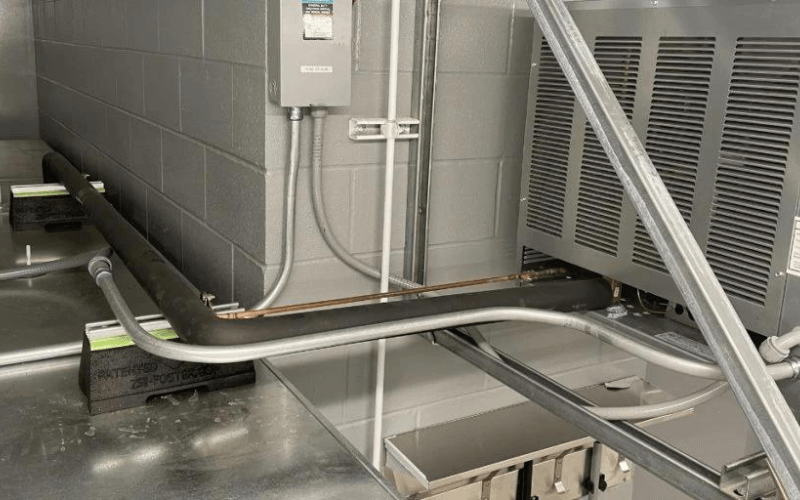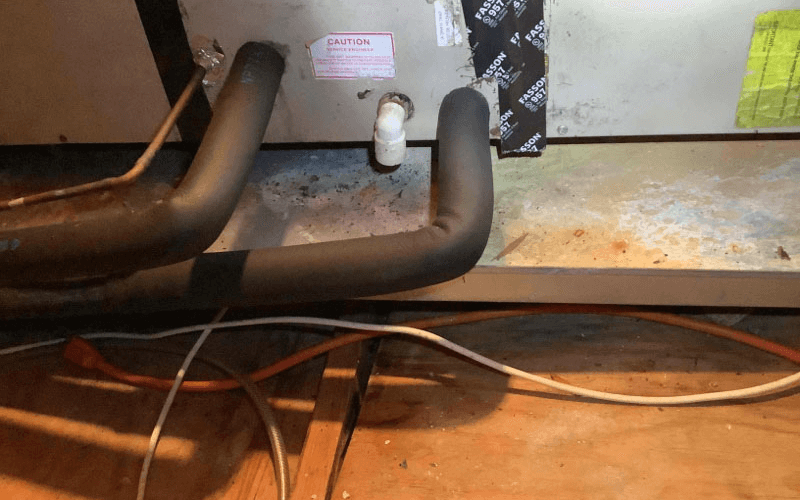To avoid back-drafting and carbon monoxide poisoning, all homeowners must be informed of the right ways to vent a gas water heater in the basement. Basement exhaust gases, even though isolated from the rest of the house, can still endanger a family’s health and safety if not properly vented. The majority of homes have a gas water heater that vents via the roof. There are choices for homeowners who want to vent water heater exhaust gases laterally.
Table of Contents
ToggleContinue reading to learn how to vent a gas water heater in the basement.
Gas Water Heater Venting Without a Chimney
There are various methods for venting a gas water heater without a chimney. These are:
- Power Venting
- Direct Venting
- The existing Chimney vent
Any water heater can make use of an electric extractor, which works by pushing exhaust gas from the unit’s top. This technique is useful for water heaters in basements where there might not be natural gas.
However, two different types of pipes are employed for direct ventilation. The first takes in oxygen for combustion, while the second emits exhaust gas. This style of direct ventilation is used in tankless water heaters and is a fantastic technique to vent water from a water heater.
Make sure the chimney duct is open and sealed if you decide to use an existing chimney for ventilation. This technique is frequently employed when installing gas water heaters in basements with outdated boilers that are no longer in use.
To make sure you have all the information you need for a safe and proper water heater, we’ll walk you through the process of unpacking your basement gas water heater in the following section.
Also, Read: How to Vent A Tankless Water Heater Properly?
How To Vent A Gas Water Heater In The Basement?
Set Up The Hot Water Vent Pipe.
Use the proper bit in your drill to make a hole big enough for the gas hot water exhaust pipe in the floor wall. Make sure the vent pipe’s diameter is greater than the wall aperture. A vent pipe with a diameter of 3 inches, for example, should fit through a 4-inch hole.
Particularly if the basement panel includes combustible materials, you don’t want the vent pipe to come into touch with the wall. The exhaust gases are very warm. They might warm up the vent pipes and start fires in combustible wall substrates.
The vent collar and storm collar should also be taken into account. Before drilling, it is essential to measure these items to make sure they will fit through the hole.
Also, Read: How Much Gas Does a Water Heater Use?
Stack The Gas Water Heater On Top Of The Ventilation Hood.
Check the draught hood before venting a water heater. Count the number of legs, taking into account the method of attachment. While some draught hoods have three legs, the bulk has four. Others employ hooks or pins, while some are secured with screws.
To avoid damaging one of the draught hood legs and needing to replace the complete unit, make sure that they are straight and stable.
In contrast to the exhaust vent, measure the vent opening on the draught hood. It should be around the same size as the vent pipe. Make sure the two holes are lined up, and place the draught hood over the gas water heater vent entry (draft hood and water heater vent).
Connect The Draught Hood To The Exhaust Vent Pipe.
You must consider your vent pipe-draft hood connection options during this stage of the installation of the hot water Tank Ventilation system. The majority of professionals advise utilizing sheet metal screws to fasten the vent pipe to the draught hood.
Avoid using aluminum tape to prevent your gas water heater vent pipe installation from receiving a failing grade from the building inspector. This material hides tiny nicks and can make it challenging to determine corrosion. Furthermore, duct tape is not allowed.
The double-walled pipe design of a Type B gas vent (also known as a B-vent) necessitates a specific installation method. Additionally, these vent pipes include exclusive locking mechanisms that need screws to secure the pipes in place before locking.
Connect The Vent Elbow To The Exhaust Vent Pipe.
Check the elbow of the exhaust vent for cracks and other signs of deterioration or damage. The draught hood, vent pipe, and the outside should all be connected continuously via the vent elbow.
Investigate the vent elbow’s joints. Can you move them at will? The ability for homeowners to change the angle of the vent elbow with respect to the vent pipe necessitates the inclusion of this feature.
Over the snap ring on the vent pipe, place the vent elbow. Rotate the elbow of the vent until the components are firmly in position. The propane water heater venting is almost complete.
Install The Storm Collar.
Take the storm collar and look for any issues. This device is crucial because it prevents elements like melting ice, rainwater, and other substances from entering the basement via the wall. It may assist in minimizing air draughts, enabling the propane heater for basement apartments to operate well.
Insert the storm collar via the elbow of the exhaust vent. Once it is firmly in place, rotate it. In order to guarantee that the gas water heater is adequately weatherproofed, install the storm collar on the basement wall.
Install The Exhaust Vent Cap.
Go outside to the location where your home’s water heater vent pipe leaves. Look at the additional water heater venting requirements that you haven’t yet met.
Replace or fix the vent cap as necessary after inspecting it for anomalies or damage. This will guarantee that everything operates without a hitch.
The vent cap should be fastened to the exterior-facing wall using the proper fasteners. Make sure that every component is airtight.
Apply Sealant.
In the water heater vent pipe, caulk screw holes, exposed edges, and other connections to other vent parts. Flue gases can still escape through small cracks in the system even though the gas water heater is situated in the basement, far from your living spaces.
Because foil tape creates a more lasting airtight seal than pipe thread sealer, it is the preferred option for most homeowners. Vent ducts and draught hoods can be sealed with duct tape. Use caution while choosing a sealant due to the hot nature of water heater vent pipes.
Conclusion
Now that you know how you can properly vent gas water heaters in basements. Although the steps are straightforward, they do need some effort. Making the right-sized hole in the basement wall is the most challenging part.
To complete the water heater exhaust system, it should be simple to connect the draught hood, vent pipe, storm collar, and vent cap.
FAQ
What is the proper way to vent a gas water heater?
The venting must be vertical or upward sloping so that hot exhaust rises through it and exits your home. When installing a normal atmospheric vent with your water heater, it is critical to ensure that your property has a fully functioning vent system.
Where should a gas water heater be vented?
Venting consists of two parts. Your water heater must properly exhaust flue gases while also drawing in fresh air. Because the exhaust contains carbon dioxide, it must be vented outdoors.
What happens if a gas water heater is not properly vented?
Carbon monoxide is one of the gases produced during burning. Carbon monoxide, being highly deadly, must be properly ventilated to avoid significant health risks. Second, incorrect venting might cause your water heater to overheat or backfire. This can be dangerous and permanently harm your water heater.





















